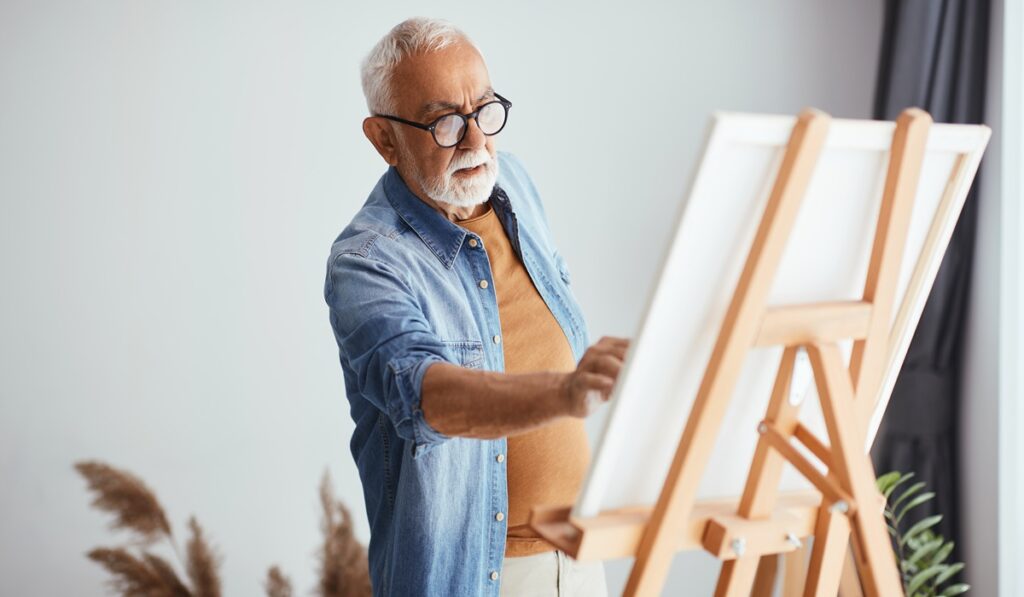As we age, the importance of staying mentally, emotionally, and socially active becomes clear. One powerful and often underappreciated tool for achieving this is art therapy for seniors. More than just a hobby, art therapy taps into the transformative power of artistic expression in seniors, helping to improve cognitive function, emotional well-being, and overall quality of life. Whether through painting, drawing, or other therapeutic art practices, creativity truly has no age limit.
According to the American Art Therapy Association, art therapy uses creative processes to help individuals improve their mental, emotional, and physical health. In senior living settings, it has become a cornerstone of elderly wellness activities, offering both joy and healing. For older adults, engaging in creative activities isn’t just about filling time — it’s about finding meaning, connection, and purpose. Art therapy encourages seniors to explore their emotions, share their stories, and stay mentally engaged in ways that promote dignity and resilience. As more senior living communities embrace these programs, they’re not only enriching daily life but also helping residents build confidence, reduce stress, and strengthen social bonds.
Key Takeaways
- Understand the purpose and power of art therapy for seniors
- Learn about the cognitive benefits of art for seniors
- Explore the emotional impact and art as emotional support in aging
- Discover practical creative aging activities and ideas for home or assisted living
- Find out how art therapy improves mental health and social engagement

What Is Art Therapy for Seniors and Why Does It Matter?
At its core, art therapy for seniors revolves around the process of creating, not the end result. Whether seniors are painting, sculpting, or making collages, the creative act itself fosters mindfulness, reduces anxiety, and boosts a sense of accomplishment. Engaging in painting activities for seniors like watercolors or acrylics offers gentle yet stimulating ways to express feelings and tell stories.
According to research published by the National Institutes of Health (NIH), creative activities such as art-making can improve cognitive function, enhance mood, and contribute to better overall health outcomes in older adults.
The Rise of Art Therapy in Senior Living Communities
Over the past decade, art therapy in senior living has become a staple in wellness programs. Communities now offer specialized art classes in assisted living, where trained professionals guide residents through projects tailored to their interests and abilities. These programs provide both therapeutic benefits and social interaction, fostering senior engagement through art and deepening connections among residents.
Cognitive and Emotional Benefits of Art Therapy for Seniors
Cognitive Benefits of Art for Seniors: Boosting Brain Health
Research shows that regular participation in creative tasks improves memory, attention, and problem-solving skills. Cognitive benefits of art for seniors include enhanced neuroplasticity, which helps keep the brain adaptable and resilient. Practicing painting and drawing for elderly individuals can also sharpen fine motor skills and coordination, offering gentle physical exercise alongside cognitive stimulation.
Emotional Benefits of Art Therapy for Elderly Adults
The emotional benefits of art therapy for elderly populations are profound. Creative work reduces feelings of loneliness, fosters self-esteem, and allows seniors to process grief or trauma in a safe and supportive setting. Art provides a non-verbal outlet for complex emotions, offering art as emotional support in aging when words are hard to find.
Seniors often report feeling calmer and more centered after participating in art therapy for adults, especially in group settings where laughter, sharing, and encouragement enhance the emotional impact.
How Art Therapy Improves Mental Health in Seniors
Reducing Anxiety, Depression, and Isolation Through Art
Mental health challenges like depression, anxiety, and social isolation are common among older adults. Art therapy for seniors helps address these issues through active engagement and emotional expression.
Key benefits of creative activities like painting, clay work, or collage:
- Provide a constructive outlet to express emotions
- Help regulate mood and reduce agitation
- Offer sensory stimulation and calming effects
- Improve sleep patterns and boost resilience
Group art classes in assisted living also help by:
- Encouraging social connection and reducing loneliness
- Building a supportive and creative community
Overall, art therapy in senior living offers both personal healing and social connection, making it a key part of elderly wellness activities.
Creative Aging Activities That Support Senior Wellness
Creative aging activities play a key role in promoting mental and emotional wellness for seniors.
Examples of impactful activities:
- Group art classes in assisted living that encourage creativity and connection
- Art shows where seniors can display their work and feel proud of their achievements
- Community mural projects that foster teamwork and senior engagement through art
Key benefits for seniors:
- Reduce loneliness and isolation
- Build confidence and self-esteem
- Provide a sense of purpose and belonging
- Support long-term mental health and resilience
These activities reflect how art therapy for seniors goes beyond individual expression — it strengthens community and enhances overall elderly wellness activities.
Art Therapy in Practice: Programs and Ideas
Art Classes in Assisted Living
Art classes in assisted living settings are designed to foster community and inclusion. Led by trained art therapists or instructors, these classes include painting, sculpting, mixed media, and textile arts. They promote senior engagement through art and offer opportunities to share personal stories, collaborate, and celebrate achievements.
Facilities often host art exhibits, allowing residents to showcase their work to family and friends, further strengthening social ties and boosting self-esteem.
What Is the Best Art Therapy for Adults?
There’s no one-size-fits-all. The best art therapy for adults often depends on the person’s interests and physical abilities. For some, watercolor painting may offer relaxation; for others, clay work provides a hands-on sensory experience. Collage, jewelry-making, and even digital art are increasingly popular.
How to Do Art Therapy at Home for Adults
Seniors can set up art therapy at home with simple supplies:
- Watercolor or acrylic paint
- Colored pencils or markers
- Modeling clay or air-dry clay
- Scrapbooking and collage materials
What Is an Alternative for Art Therapy? Exploring Other Creative Outlets
While art therapy for seniors is powerful, there are many other creative and expressive activities that bring similar cognitive and emotional benefits. These alternatives can fit a wide range of abilities and interests and are commonly used in elderly wellness activities to support well-being.
Some meaningful alternatives include:
- Music therapy: Singing, playing an instrument, or listening to favorite songs can uplift mood, stimulate memory, and encourage movement.
- Dance and movement: Chair exercises, gentle stretching, or dancing improve physical health and offer emotional release.
- Gardening: Tending to plants provides sensory stimulation, physical activity, and a sense of accomplishment.
- Creative writing or storytelling: Journaling, writing poetry, or recording life stories helps preserve memories and supports mental agility.
- Cooking or baking: Preparing meals can be a highly sensory and creative experience, offering both pleasure and achievement.
By exploring a variety of outlets, seniors can discover what brings them joy, meaning, and connection — whether through art therapy for adults or other forms of creative expression.
What Is the Most Common Form of Art Therapy? Understanding the Basics
The most common forms of art therapy for seniors include drawing, painting, and collage, as they are easy to adapt and require minimal equipment. These activities are frequently used in elderly wellness activities across community centers, assisted living facilities, and clinical settings to promote emotional expression, reduce stress, and improve fine motor skills.
However, art therapy in senior living today goes beyond these traditional forms. Many programs also incorporate:
- Sculpting or working with clay, which offers a hands-on, sensory experience
- Textile arts like knitting, quilting, or weaving, which engage both creativity and dexterity
- Music and movement-based creative activities, which combine emotional expression with physical engagement
- Photography or digital art projects, which allow seniors to explore modern tools and tell stories visually
A publication from the Cleveland Clinic explains that common forms of art therapy like drawing, painting, and collage help people explore emotions, improve self-awareness, and manage stress. For older adults, these creative outlets are especially valuable because they are accessible, adaptable, and can be tailored to various physical or cognitive abilities, making them a popular choice in both clinical and community settings.
By offering diverse options, art classes in assisted living can cater to different interests and abilities, ensuring that every resident finds a meaningful, enjoyable way to participate.
Conclusion
Art therapy for seniors is not just an activity—it’s a transformative tool that supports cognitive, emotional, and social health. From cognitive benefits of art for seniors to the emotional benefits of art therapy for elderly adults, creative engagement enriches the lives of older adults in powerful ways. Assisted living communities that offer art classes in assisted living and creative aging activities provide an invaluable service, helping seniors thrive at every level.
At Serenity Assisted Living Home Care, dedicated caregivers can help detect early signs of mental or emotional distress, encourage participation in creative programs, and ensure that each resident has access to enriching activities tailored to their needs. Contact us today and discover how we can help your loved ones.
Common Questions About Art Therapy for Seniors
How does art therapy help seniors?
Art therapy helps seniors improve memory, reduce stress, increase self-esteem, and enhance social connections, offering both cognitive and emotional benefits.
What is the best art therapy for adults?
Drawing, painting, and clay work are among the best forms, but the choice depends on personal interests and abilities.
How to do art therapy at home for adults?
Set up simple art supplies, create a calm space, and focus on the process of creating—not the result. Include family or friends for added enjoyment.
Can I do art therapy by myself?
Absolutely. Independent activities like watercolor painting, drawing, or journaling can offer profound artistic expression in seniors.
What is an alternative for art therapy?
Music, dance, or writing can provide similar emotional and cognitive benefits.
What is the most common form of art therapy?
Painting and drawing remain the most popular because they’re accessible, versatile, and adaptable for all abilities.

